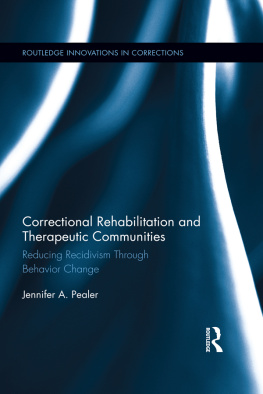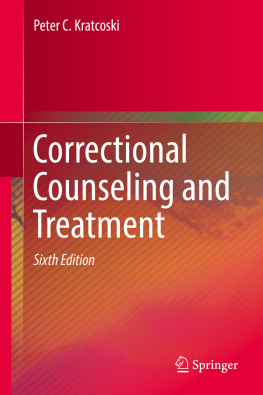
The Future of Correctional Rehabilitation
Since the founding of the penitentiary nearly two centuries ago, modern correctional systems have been marked by the belief that offenders should not only be punished but also rehabilitated. This uplifting goal, however, involves a very practical challenge: knowing how to save offenders from a life in crime.
In the aftermath of Martinsons 1974 nothing works doctrine, scholars have made a concerted effort to develop an evidence-based corrections theory and practice to show what works to change offenders. Perhaps the most important contribution to this effort was made by a group of Canadian psychologists, most notably Donald Andrews, James Bonta, and Paul Gendreau, who developed a treatment paradigm called the Risk-Need-Responsivity (RNR) model, which became the dominant theory of correctional treatment. This approach was more recently challenged by a perspective developed by Tony Ward, Shadd Maruna, and others, called the Good Lives Model (GLM). Based in part on desistance research and positive psychology, this model proposes to rehabilitate offenders by building on the strengths offenders possess. GLM proponents see the RNR model as a deficit model that fixes dynamic risk factors rather than identifying what offenders value most, and using these positive factors to pull them out of crime.
Through a detailed examination of both models theoretical and correctional frameworks, The Future of Correctional Rehabilitation: Moving Beyond the RNR Model and Good Lives Model Debate probes the extent to which the models offer incompatible or compatible approaches to offender treatment, and suggests how to integrate the RNR and GLM approaches to build a new and hopefully more effective vision for offender treatment. A foreword by renowned criminologist Francis T. Cullen helps put the material into context. This book will be of much interest to scholars and students interested in correctional rehabilitation as well as practitioners working with offenders.
Ronen Ziv, PhD, is a research fellow of the University of Cincinnati Corrections Institute and a teaching fellow in the Department of Social Sciences, School of Criminology, at the University of Haifa, Israel. He received his MS (2012) and PhD (2016) in criminal justice from the University of Cincinnati. Previously, he received his LLB (2005) and LLM (2006) in Law from Tel-Aviv University and worked as a criminal defense lawyer. His current research interests are in developing and testing the evidence-based approach to correctional rehabilitation, the integration of motivational theories in correctional intervention, and the capacity of correctional agencies to implement a promising correctional framework that aims to rehabilitate offenders.
First published 2018
by Routledge
711 Third Avenue, New York, NY 10017
and by Routledge
2 Park Square, Milton Park, Abingdon, Oxon, OX14 4RN
Routledge is an imprint of the Taylor & Francis Group, an informa business
2018 Taylor & Francis
The right of Ronen Ziv to be identified as author of this work has been asserted by him in accordance with sections 77 and 78 of the Copyright, Designs and Patents Act 1988.
All rights reserved. No part of this book may be reprinted or reproduced or utilised in any form or by any electronic, mechanical, or other means, now known or hereafter invented, including photocopying and recording, or in any information storage or retrieval system, without permission in writing from the publishers.
Trademark notice: Product or corporate names may be trademarks or registered trademarks, and are used only for identification and explanation without intent to infringe.
Library of Congress Cataloging-in-Publication Data
Names: Ziv, Ronen, author.
Title: The future of correctional rehabilitation : moving beyond the RNR model and good lives
model debate / Ronen Ziv.
Description: New York, NY : Routledge, 2018.
Identifiers: LCCN 2017019045 | ISBN 9781138095960 (hardback) | ISBN 9781138095984 (pbk.)
Subjects: LCSH: CriminalsRehabilitationUnited States. | CorrectionsUnited States.
Classification: LCC HV9304 .Z58 2018 | DDC 365/.6610973dc23
LC record available at https://lccn.loc.gov/2017019045
ISBN: 978-1-138-09596-0 (hbk)
ISBN: 978-1-138-09598-4 (pbk)
ISBN: 978-1-315-10550-5 (ebk)
Typeset in Bembo
by Apex CoVantage, LLC
To my family and the people in the field of correctional rehabilitation.
Contents
by Francis T. Cullen
PART I
Beyond Nothing Works
PART II
The Risk-Need-Responsivity Model
PART III
The Good Lives Model
PART IV
The Future of Rehabilitation
I entered the field of criminology in the mid-1970s and eventually was moved, with Karen Gilbert in 1982, to write Reaffirming Rehabilitation. At this time, I was in a distinct minority in arguing that the rehabilitative ideal should remain the guiding correctional paradigm. Virtually every scholar I encountered, including most of my criminological friends, believed that offender treatment was an intractably flawed and failed enterprise. The dismal state of the nations correctional institutions, marked most notably by the lethal suppression of the Attica inmate uprising, made it difficult to imagine that these could ever be therapeutic communities. Most troubling, Robert Martinsons summary of 231 evaluations in The Public Interest reported that no reliably effective intervention reduced recidivism. With his study, evidence-based corrections had arrived and delivered a stunning message: nothing works in offender treatment.
While a graduate student at Columbia University, I interviewed with Martinson for a researcher position on a follow-up study to his nothing works project. My lack of computer skills undermined my employability, but it was still a thrill to meet him. At that time, I was writing a lot on labeling theory, a perspective that reminded us that state intervention not only did not work but also made offenders worse off. I was a committed member of the nothing works gang.
But I would change my mind a few years later. In the summer of 1979, I was attending a seminar at the University of Virginia funded by the National Endowment for the Humanities and run by Gresham Sykes. I decided to write a seminar paper critical of correctional rehabilitation. For some reason that still escapes me, a disquieting thought popped into my mind: Why would we expect a system that explicitly tried to punish offenders to be more just and effective than a system that at least aspired to rehabilitate them? My sense was that critics of treatment did not consider the unanticipated consequences of their policy alternatives, especially the embrace of determinate sentencing and the abolition of parole release. In Reaffirming Rehabilitation , Karen and I predicted that greater punitiveness could result. Unfortunately, we proved prescient.
Still, the Martinson study remained. Even if my dire warnings had merit, how could I support something that did not work? Practicing a lot of confirmation bias, I soon took solace in reading rebuttals to the nothing works doctrine that listed tens of effective programsespecially those written by Ted Palmer and by Paul Gendreau and Robert Ross. I chose to believe that the glass was half full and not half empty. Paul, in particular, became a close friendhis letter to me following the publication of Reaffirming Rehabilitation leading to more exchanges and then to collaborations. Eventually, a series of meta-analyses appeared, most notably by Mark Lipsey and colleagues, which showed more definitively that rehabilitation programs were effective. They also revealed that punishment-oriented programsthose that sought to change offenders through scare tactics, discipline, threats, intensive supervisionwere dismal failures. Alas, in the end, we learned that rehabilitation works and punishment does not.






